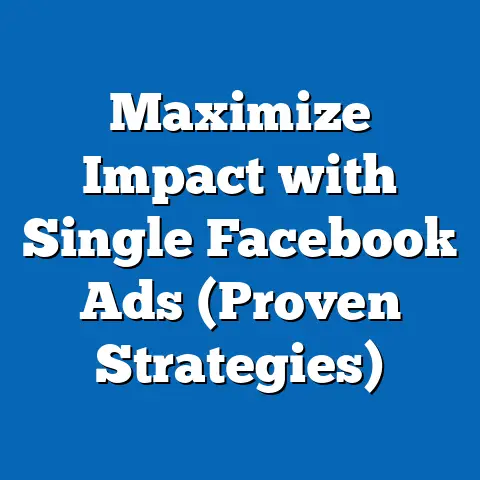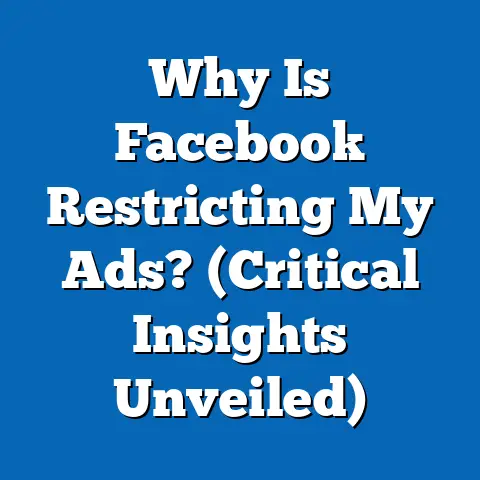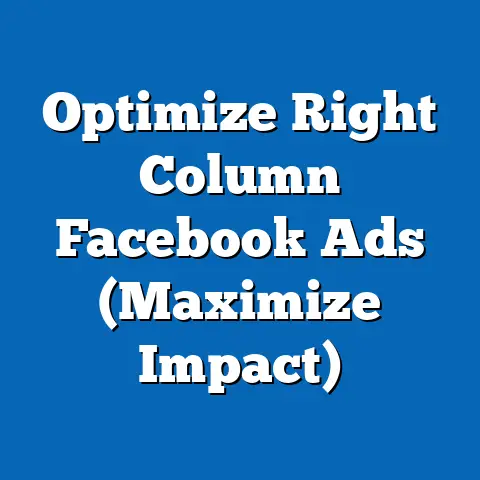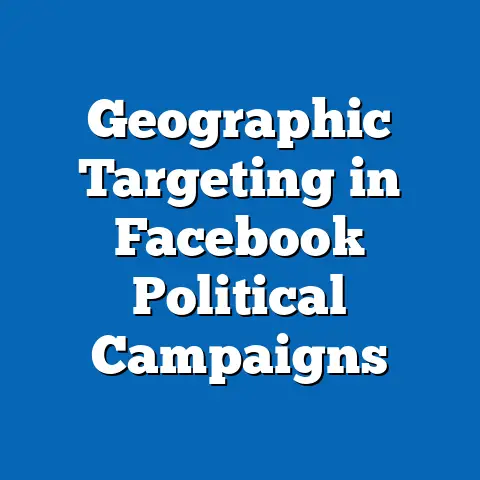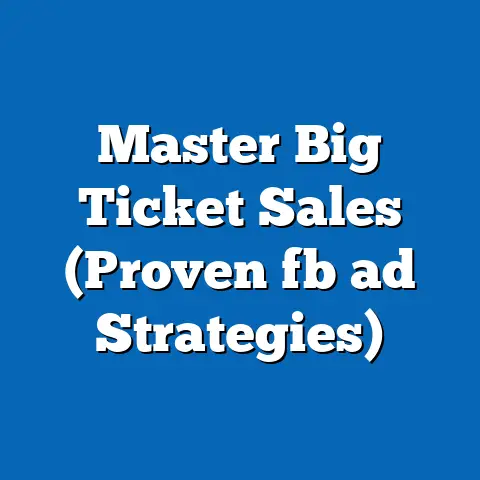Combat Ageism in Facebook Job Ads (Insightful Strategies)
How can companies harness the diverse talents of all age groups to foster innovation and growth in their workforce? This is a question I’ve been pondering for years, witnessing firsthand how ageism, often subtle and insidious, can stifle potential and limit the richness of a company’s talent pool. In today’s digital age, where Facebook has become a dominant platform for job advertising, understanding and combating ageism in these ads is more crucial than ever. This article delves into the heart of this issue, offering practical strategies for creating truly inclusive hiring practices.
Understanding Ageism in the Workplace
Ageism, simply put, is discrimination and stereotyping based on age. While it can affect individuals of any age, it disproportionately impacts older workers. In the job market, ageism often manifests as a reluctance to hire, promote, or train older individuals, based on assumptions about their skills, adaptability, or energy levels.
The statistics are sobering. According to a 2020 AARP survey, nearly two-thirds of older workers have experienced age discrimination. This isn’t just anecdotal; it’s a pervasive issue that impacts millions. The EEOC (Equal Employment Opportunity Commission) receives thousands of age discrimination complaints every year, highlighting the ongoing struggle against this bias.
The impact of ageism is far-reaching. For job seekers, it can lead to prolonged unemployment, financial hardship, and a decline in self-esteem. For employers, it means missing out on a wealth of experience, skills, and institutional knowledge. A multigenerational workforce brings diverse perspectives, enhances creativity, and improves problem-solving capabilities. Ignoring the potential of older workers isn’t just unethical; it’s bad for business. I’ve seen teams thrive when they leverage the wisdom of seasoned professionals alongside the innovative energy of younger talent. It’s a powerful combination that ageism actively undermines.
Takeaway: Ageism is a significant problem in the workplace with substantial negative consequences for both individuals and organizations. Recognizing its prevalence is the first step towards combating it.
The Role of Facebook in Job Advertising
Facebook’s reach is undeniable. With billions of users worldwide, it’s become a prime platform for employers to advertise job openings. The ability to target specific demographics, interests, and behaviors makes it a powerful tool for recruitment. However, this power comes with responsibility.
Facebook’s algorithmic targeting, while efficient, can inadvertently perpetuate age-related biases. For instance, if an ad is initially shown to a younger demographic and receives positive engagement, the algorithm might prioritize showing it to similar users, effectively excluding older candidates. Similarly, the use of age-specific language or imagery in job ads can signal a preference for younger workers, even if unintentionally.
I’ve witnessed this firsthand when consulting with companies on their Facebook ad campaigns. Sometimes, the targeting parameters, though seemingly innocuous, were subtly filtering out qualified older candidates. It’s a reminder that even the most sophisticated algorithms are only as unbiased as the data they’re fed and the parameters they’re set.
Furthermore, the informal and visually-driven nature of Facebook can contribute to ageism. Ads that feature youthful imagery or language that resonates primarily with younger audiences can inadvertently create a perception that the company is not welcoming to older workers.
Takeaway: Facebook’s powerful advertising platform can be a valuable recruitment tool, but it also carries the risk of perpetuating ageism if not used responsibly. Understanding how the platform works and being mindful of potential biases is essential.
Strategies to Combat Ageism in Facebook Job Ads
Combating ageism in Facebook job ads requires a multi-faceted approach, encompassing inclusive language, responsible targeting, and a commitment to showcasing a diverse and welcoming company culture. Here are some specific strategies I recommend:
Inclusive Language
The language used in job descriptions is crucial. Avoid phrases that explicitly or implicitly favor younger candidates. Terms like “digital native,” “recent graduate,” or “high-energy” can send the message that older workers are not welcome.
Instead, focus on skills, experience, and qualifications that are relevant to the job. Use age-neutral language that emphasizes the value of experience and expertise. For example, instead of “digital native,” consider “proficient in digital marketing tools.” Instead of “recent graduate,” try “entry-level position.”
Here are some examples:
- Instead of: “Looking for a high-energy go-getter” Try: “Seeking a motivated and results-oriented individual”
- Instead of: “Digital native with a passion for social media” Try: “Experienced in social media marketing with a strong understanding of digital trends”
- Instead of: “Recent graduate eager to learn” Try: “Entry-level position with opportunities for professional development”
I’ve seen companies dramatically improve their applicant pool diversity simply by revising their job descriptions to use more inclusive language. It’s a small change that can make a big difference.
Targeted Ad Settings
Facebook’s audience targeting tools can be used to reach a broad range of candidates, regardless of age. Avoid setting age restrictions or targeting only specific age groups. Instead, focus on interests, skills, and experiences that are relevant to the job.
Consider using “broad targeting,” which allows Facebook’s algorithm to identify and deliver your ad to the most relevant users based on their behavior and interests, without explicitly specifying age ranges. This can help to mitigate potential biases and ensure that your ad reaches a diverse audience.
However, it’s important to monitor your ad performance and adjust your targeting as needed. If you notice that your ad is primarily being shown to a specific age group, you may need to refine your targeting parameters to ensure that you’re reaching a broader audience.
Highlighting Company Culture
Showcasing a diverse and inclusive workplace culture can attract talent from all age groups. Feature employees of different ages, backgrounds, and experiences in your Facebook ads and on your company’s career page. Highlight initiatives that promote diversity and inclusion, such as mentorship programs, employee resource groups, and flexible work arrangements.
I’ve worked with companies that have created compelling video testimonials featuring employees of different ages talking about their experiences working at the company. These videos not only showcase the company’s commitment to diversity but also provide potential candidates with a glimpse into the company’s culture.
Emphasize the value of experience and the contributions that older workers bring to the team. Highlight opportunities for professional development and growth, regardless of age.
Employee Testimonials
Featuring testimonials from employees of various age groups is a powerful way to demonstrate a welcoming environment. Storytelling is incredibly effective in breaking down stereotypes and showcasing the value of a multigenerational workforce.
Encourage employees to share their experiences working at the company, highlighting the benefits of working alongside colleagues of different ages and backgrounds. These testimonials can be featured in your Facebook ads, on your company’s career page, and on your social media channels.
Training Hiring Managers
Implementing training programs for hiring managers to recognize and combat their own biases is essential. Unconscious bias can creep into the hiring process, even with the best intentions. Training can help hiring managers become more aware of their biases and develop strategies to mitigate them.
These training programs should cover topics such as ageism, unconscious bias, and inclusive hiring practices. They should also provide practical tips and tools for conducting fair and unbiased interviews.
Takeaway: Combating ageism in Facebook job ads requires a proactive and multi-faceted approach. By using inclusive language, responsible targeting, highlighting company culture, featuring employee testimonials, and training hiring managers, companies can create a more equitable and inclusive hiring process.
Case Studies of Successful Campaigns
Let’s look at some real-world examples of companies that have successfully combated ageism in their Facebook job ads:
- Company A (Tech Industry): This company, facing criticism for its predominantly young workforce, launched a campaign featuring employees of all ages and backgrounds. They highlighted the value of experience and the opportunities for professional development at the company. The campaign resulted in a significant increase in applications from older candidates and a more diverse workforce.
- Company B (Retail Industry): This company revised its job descriptions to use more inclusive language and removed age restrictions from its targeting parameters. They also created a video testimonial featuring employees of different ages talking about their experiences working at the company. The campaign resulted in a more diverse applicant pool and a more engaged workforce.
- Company C (Healthcare Industry): This company implemented training programs for hiring managers to recognize and combat their own biases. They also created a mentorship program that paired younger employees with more experienced colleagues. The campaign resulted in a more inclusive hiring process and a more supportive work environment.
These case studies demonstrate that combating ageism in Facebook job ads is not only possible but also beneficial for companies. By implementing the strategies outlined above, companies can create a more equitable and inclusive hiring process and build a more diverse and engaged workforce.
Takeaway: Real-world examples show that combating ageism in Facebook job ads can lead to positive outcomes, including increased diversity, improved employee engagement, and a more inclusive work environment.
The Long-term Benefits of Age Diversity in the Workplace
The benefits of a multigenerational workforce extend far beyond simply avoiding age discrimination. Age diversity fosters enhanced creativity, innovation, and problem-solving capabilities.
Older workers bring a wealth of experience, skills, and institutional knowledge to the table. They can provide valuable mentorship to younger employees and help to navigate complex challenges. Younger workers, on the other hand, bring fresh perspectives, innovative ideas, and a strong understanding of emerging technologies.
By leveraging the unique strengths of employees from different age groups, companies can create a more dynamic and innovative work environment. This can lead to improved productivity, increased profitability, and a stronger competitive advantage.
Furthermore, a multigenerational workforce can improve employee engagement and retention. When employees feel valued and respected, regardless of their age, they are more likely to be engaged in their work and committed to the company.
Takeaway: Age diversity is not just about fairness; it’s about creating a more innovative, productive, and engaged workforce. Embracing age diversity can lead to significant long-term benefits for companies.
Conclusion
Combating ageism in Facebook job ads is not just the right thing to do; it’s the smart thing to do. By using inclusive language, responsible targeting, highlighting company culture, featuring employee testimonials, and training hiring managers, companies can create a more equitable and inclusive hiring process and build a more diverse and engaged workforce.
I encourage you to take action today to re-evaluate your hiring practices and embrace the benefits of age diversity. Start by reviewing your job descriptions and identifying any language that could be perceived as ageist. Adjust your Facebook ad targeting parameters to ensure that you’re reaching a broad range of candidates. Showcase your company’s commitment to diversity and inclusion on your career page and in your social media channels.
By taking these steps, you can create a more equitable job market and build a more successful and sustainable business. The future of work is inclusive, and it’s time to embrace the talents of all age groups.
Let’s work together to create a future where age is not a barrier to opportunity, but rather a valuable asset in the workplace.

